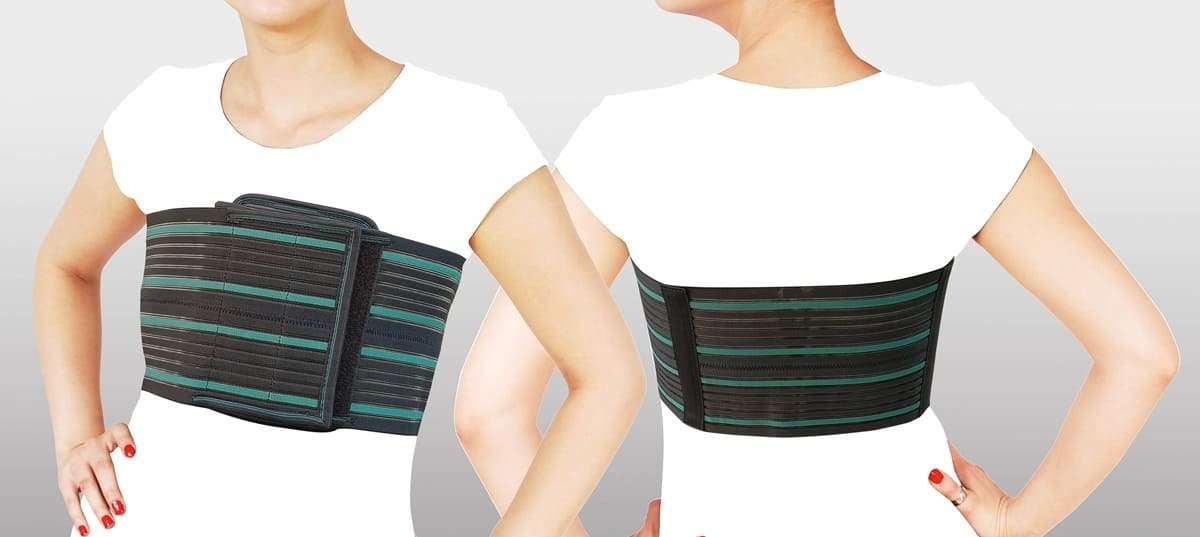A Rib Belt is a medical support device designed to provide compression and stabilization to the rib cage, usually for individuals recovering from rib fractures, chest injuries, or surgeries. It is typically made of elastic, breathable material with an adjustable Velcro closure to ensure a snug but comfortable fit around the chest.

Detailed Benefits of a Rib Belt
A Rib Belt is a medical support device that provides compression and stability to the chest area, particularly for individuals recovering from rib injuries or surgeries. Below are its detailed benefits:
Pain Relief
- The compression provided by a rib belt helps reduce pain by stabilizing the injured ribs and preventing excessive movement.
- It minimizes discomfort while coughing, sneezing, or taking deep breaths.
- By offering gentle pressure, it helps reduce the risk of sudden, sharp pain due to rib fractures or injuries.
Stabilization & Support
- A rib belt keeps the rib cage properly aligned, ensuring that fractured or bruised ribs heal correctly.
- It reduces unnecessary rib movement, preventing further injury or strain.
- Helps patients regain mobility without worsening their condition.
Protection from External Pressure
- The rib belt acts as a protective barrier against accidental bumps or pressure on the chest.
- This is especially helpful for individuals recovering from rib fractures, contusions, or surgeries, as sudden impacts can delay healing.
Post-Surgical Recovery Aid
- Used after thoracic (chest) surgeries, such as heart or lung procedures, to provide gentle compression and support the chest muscles.
- Helps prevent excessive strain on stitches or surgical incisions, promoting faster recovery.
- Aids in maintaining postural stability, ensuring that the chest is properly aligned.
Improved Breathing Efficiency
- Provides gentle compression that can help patients control their breathing, reducing discomfort associated with deep breaths.
- Helps individuals breathe in a more controlled and steady manner, minimizing pain while inhaling and exhaling.
- Prevents shallow breathing, which can lead to complications like pneumonia in post-surgical patients.
Enhanced Mobility & Comfort
- With better rib support, individuals can move more comfortably, allowing them to resume daily activities with less discomfort.
- Helps prevent muscle fatigue and strain in the chest area by offering additional support.
- Reduces anxiety and hesitation in movement, which can be common after a rib injury.
Aids in Healing & Recovery
- The compression helps in reducing swelling and inflammation in the affected area.
- Promotes better circulation, which aids in faster healing of fractured or bruised ribs.
- Provides a feeling of security, which can be psychologically beneficial for the patient.
Easy to Use & Adjustable
- Rib belts are lightweight, breathable, and adjustable, making them comfortable for long-term use.
- Can be worn discreetly under clothing, allowing patients to go about their day without discomfort.
- The Velcro closure ensures a customized fit, allowing the patient to adjust the tightness as needed.
Precautions While Using a Rib Belt
- Do not wear it too tightly, as it may restrict breathing and reduce lung function.
- Not recommended for prolonged use without a doctor’s consultation, as over-reliance can weaken chest muscles.
- People with respiratory conditions (like COPD or asthma) should consult a physician before use.
- Remove the belt periodically to allow the chest muscles to function naturally and avoid excessive compression.
Who Can Benefit from a Rib Belt?
- Individuals recovering from rib fractures or contusions
- Post-surgical patients (heart, lung, or chest surgeries)
- People with costochondritis (rib cartilage inflammation)
- Those suffering from muscle strains or chest wall injuries
- Individuals needing chest support for weak muscles
Role of Rib Belt in Rehabilitation Aids:
Support & Stabilization: Helps limit excessive movement of the rib cage, reducing pain and promoting healing after rib fractures or chest surgeries.
Pain Relief: The compression provided by the rib belt helps alleviate discomfort by reducing the strain on injured ribs.
Post-Surgical Recovery: Used in post-thoracic surgeries (like heart or lung surgery) to provide support and minimize strain during movement or breathing.
Improved Breathing Efficiency: By offering mild compression, it can help patients control their breathing patterns, reducing the risk of sharp pain associated with deep breaths.
Enhanced Mobility: Allows individuals to move more comfortably without exacerbating their injuries.
Protection: Acts as a protective layer against external pressure or accidental bumps.
When to Use a Rib Belt?
- After rib fractures or contusions
- Following chest or thoracic surgery
- For conditions like costochondritis (inflammation of rib cartilage)
- To support weak or strained chest muscles
Precautions:
- Should not be worn too tightly, as excessive compression may restrict breathing.
- Long-term use is not recommended without medical advice, as it may lead to muscle weakness.
- Consult a doctor before using it, especially if there are breathing difficulties or underlying lung conditions.
Conclusion
A rib belt is a valuable rehabilitation aid that provides support, pain relief, and stability for individuals recovering from rib-related injuries. While it significantly enhances comfort and mobility, it should be used under medical supervision to avoid complications.
